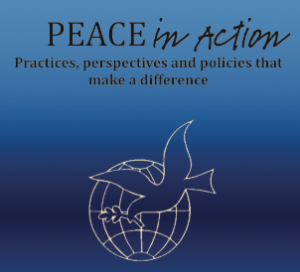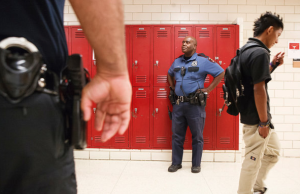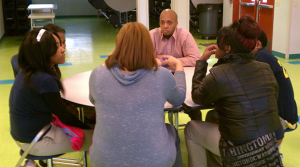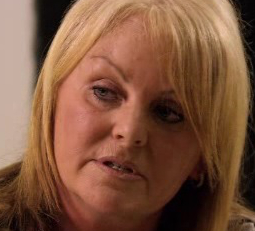News & Announcements
- Details
- Written by Joshua Wachtel
 In a sprawling school district in northeast Ontario, Canada, with six secondary and 18 primary schools, restorative practices have not only reduced suspensions, but also helped change student behavior, according to an article by Brenden Harris in KenoraOnline. Restorative practices have been rolled out district wide, and were introduced with the support of Bruce Schenk, director of IIRP Canada.
In a sprawling school district in northeast Ontario, Canada, with six secondary and 18 primary schools, restorative practices have not only reduced suspensions, but also helped change student behavior, according to an article by Brenden Harris in KenoraOnline. Restorative practices have been rolled out district wide, and were introduced with the support of Bruce Schenk, director of IIRP Canada.
The Keewatin-Patricia District School Board is pleased with the results of their safe and supportive schools initiatives. Safe and supportive schools coordinator Al Wray says they've seen a continued drop in the number of suspensions over the last decade.
- Details
- Written by Laura Mirsky
 IIRP assistant professor and director of Continuing Education John Bailie at a Basic Restorative Practices event in Singapore
IIRP assistant professor and director of Continuing Education John Bailie at a Basic Restorative Practices event in Singapore
Lutheran Community Care Services Ltd. (LCCS), a new IIRP affiliate in the Republic of Singapore, hosted IIRP assistant professor and director of Continuing Education Dr. John Bailie in presenting a four-day Basic Restorative Practices event in the Southeast Asian island city-state in March. Twelve participants from the fields of education, residential care and prison services attended the event.
LCCS executive director Daniel Ang has been the driving force behind bringing restorative practices to Singapore. Asked what had motivated him to bring the practices to his country, Ang wrote, “Restorative Practices is evidence-based. The practice impacts people and organization’s narrative that is life changing and culture transforming. I am excited to be part of this movement worldwide. Dr. John Bailie’s visit marks a significant milestone for the Lutheran Community Care Services as it formalised our relationships with IIRP as an affiliate partner. This relationship helps us to bring a wealth of knowledge, resources and training to Singapore.”
- Details
- Written by Joshua Wachtel
 Ian Marder, a criminologist working as Project Manager at the Restorative Justice Council, writes about restorative conferencing in the UK for the TransConflict web site:
Ian Marder, a criminologist working as Project Manager at the Restorative Justice Council, writes about restorative conferencing in the UK for the TransConflict web site:
For those of us in England and Wales, however, the Northern Irish youth justice process is probably the best known example of restorative justice being fully integrated into the criminal justice process at this time (albeit only for juvenile offenders). Prior to sentencing, the Courts, in almost all situations, must refer cases to the dedicated Youth Conferencing Service, whose job it is to prepare, facilitate and follow up on restorative conferences involving offenders, victims, and the supporters of both parties. A comprehensive evaluation of this process revealed highly positive feedback from participating victims: 81% preferred restorative conferencing to the court process, while 88% said that they would recommend it to a friend.
- Details
- Written by Joshua Wachtel
Last week I posted a link to a new report issued by the Civil Rights Project at University of California, Los Angeles, ”Out of School & Off Track: The Overuse of Suspensions in American Middle and High Schools.” Below, you'll find a 10-minute video from Huffington Post with co-author of the report Daniel Losen, Director of the Center for Civil Rights Remedies.
Losen discusses the report and the fact that suspensions for minority students have been on the rise over the past three decades. He notes that suspensions are "not a good way to address typical adolescent behavior," though as many as 25% of certain group of students got suspended in 2009-10 in some schools.
- Details
- Written by Joshua Wachtel
 Terry O'Connell has a chapter, called "Conflict and Relationships: Restorative Ways of Building Community," in a new book titled Peace in Action: Practices, Policies and Perspectives That Make a Difference, edited by Raymond John R. King, Victor MacGill, Roger Wescombe. The book is a collection of papers from the Rotary Peace Communities International Conference held in Wagga Wagga, New South Wales, Australia, in 2012. Terry is director of Real Justice Australia, and he developed the Real Justice script and the restorative questions. I've posted three excerpts here, including the introduction and two anecdotes taken from Terry's influence on people adopting restorative practices for use in the business world.
Terry O'Connell has a chapter, called "Conflict and Relationships: Restorative Ways of Building Community," in a new book titled Peace in Action: Practices, Policies and Perspectives That Make a Difference, edited by Raymond John R. King, Victor MacGill, Roger Wescombe. The book is a collection of papers from the Rotary Peace Communities International Conference held in Wagga Wagga, New South Wales, Australia, in 2012. Terry is director of Real Justice Australia, and he developed the Real Justice script and the restorative questions. I've posted three excerpts here, including the introduction and two anecdotes taken from Terry's influence on people adopting restorative practices for use in the business world.
Introduction
Recently I ran a restorative session for about 120 Year five students (aged 10-11) in a primary school. The initial discussion focused on their relationships with one another and their families. Most said that friendships were the most important part of their school experience. I posed the question ‘If today was the last day of your primary schooling and as you looked back you discovered that in all the years you were together as a group, you had never had a conflict, a fight or disagreement, what would that be like?’
- Details
- Written by Joshua Wachtel
 Photo by Michael Stravato for the New York TimesPhiladelphia youth activists explain and critique the school-to-prison pipeline in On Blast, a seven-minute podcast. Their description of the recording states:
Photo by Michael Stravato for the New York TimesPhiladelphia youth activists explain and critique the school-to-prison pipeline in On Blast, a seven-minute podcast. Their description of the recording states:
The School-to-Prison Pipeline is a disturbing national trend wherein children are funneled out of public schools and into the juvenile and criminal justice systems. Members of the Philadelphia Student Union created the Campaign for Nonviolent Schools (CNS) to work towards improving school climates and ending the School-to-Prison Pipeline.
On Blast youth radio producer, Julian Roessler, explains a youth perspective on the School-to-Prison Pipeline. Julian interviews Josh Glenn, an organizer with YASP (Youth Art & Self-Empowerment Project) and Decarcerate PA. Josh is also a member of CNS. Together, they explore the deeper roots of the School-to-Prison Pipeline.
Listen to the podcast here.
- Details
- Written by Joshua Wachtel
 Photo by Black Rock Solar, Flickr Creative CommonsIn a new report issued by the Civil Rights Project at University of California, Los Angeles,"Out of School & Off Track: The Overuse of Suspensions in American Middle and High Schools," Daniel J. Losen and Tia Elena Martinez analyze data from over 26,000 U.S. middle and high schools. In their executive summary, they write:
Photo by Black Rock Solar, Flickr Creative CommonsIn a new report issued by the Civil Rights Project at University of California, Los Angeles,"Out of School & Off Track: The Overuse of Suspensions in American Middle and High Schools," Daniel J. Losen and Tia Elena Martinez analyze data from over 26,000 U.S. middle and high schools. In their executive summary, they write:
[W]e estimate that well over two million students were suspended during the 2009-2010 academic year. This means that one out of every nine secondary school students was suspended at least once during that year. As other studies demonstrate, the vast majority of suspensions are for minor infractions of school rules, such as disrupting class, tardiness, and dress code violations, rather than for serious violent or criminal behavior. Serious incidents are rare and result in expulsions, which are not covered by this report.
- Details
- Written by Joshua Wachtel
 Talking circle / photo by Christianity Today
Talking circle / photo by Christianity Today
Here's an excerpt from an excellent article that appeared this week in Christianity Today. "Detroit Students Restore Peace by Talking It Out" by Charles Honey begins with an anecdote of a restorative circle used to resolve an argument that led to threats, which took place one weekend between a group of teenaged girls over social media. The article then goes on to quote Henry McClendon, Michigan Regional Coordinator for the IIRP, who talks about his desire to see successful school-based restorative practices programs expand out to surrounding neighborhoods.
"It's my personal mission to see Detroit become the first large, urban restorative city," says Henry McClendon, a Christian minister and executive of the Skillman Foundation, a private nonprofit focused on improving schools and neighborhoods for children. He has spearheaded implementing restorative practices in schools and among law enforcement and community groups.
- Details
- Written by Joshua Wachtel
 The UK Restorative Justice Council (RJC) featured the following news in a recent email:
The UK Restorative Justice Council (RJC) featured the following news in a recent email:
In 2009, Clare Topcu and her nine year old son were the victims of a robbery, which had a devastating effect on their lives.
Two men broke into their house while they slept, and Clare was knocked unconscious. She came round to find herself bound with packing tape, and her son being held at knife-point. When Clare’s husband returned home, the burglars fled with £9,000, leaving Clare and her son terrified and badly beaten.
- Details
- Written by Joshua Wachtel
 Photo by Jim Wilson at the New York Times
Photo by Jim Wilson at the New York Times
A second article this week, about a restorative justice program in schools in Oakland, California, has appeared in a national publication, this one in the New York Times. In a piece titled, "Opening up, students transform a vicious circle," Patricia Lee Brown writes, "The approach now taking root in 21 Oakland schools, and in Chicago, Denver and Portland, Ore., tries to nip problems and violence in the bud by forging closer, franker relationships among students, teachers and administrators." The entire piece may be found here.
IIRP President Ted Wachtel has responded to the piece in his blog column at the Huffington Post, advocating "Restorative justice practices in every classroom." He writes, "I was delighted to see another New York Times article about restorative justice. ... Just across the Bay, schools in San Francisco, as well as in Detroit, Baltimore, Philadelphia, New York and hundreds of other urban, suburban and rural communities, are adopting an approach that puts restorative practices in every classroom in the building." Read the entire piece here.

Restorative Works Year in Review 2024 (PDF)
All our donors are acknowledged annually in Restorative Works.
